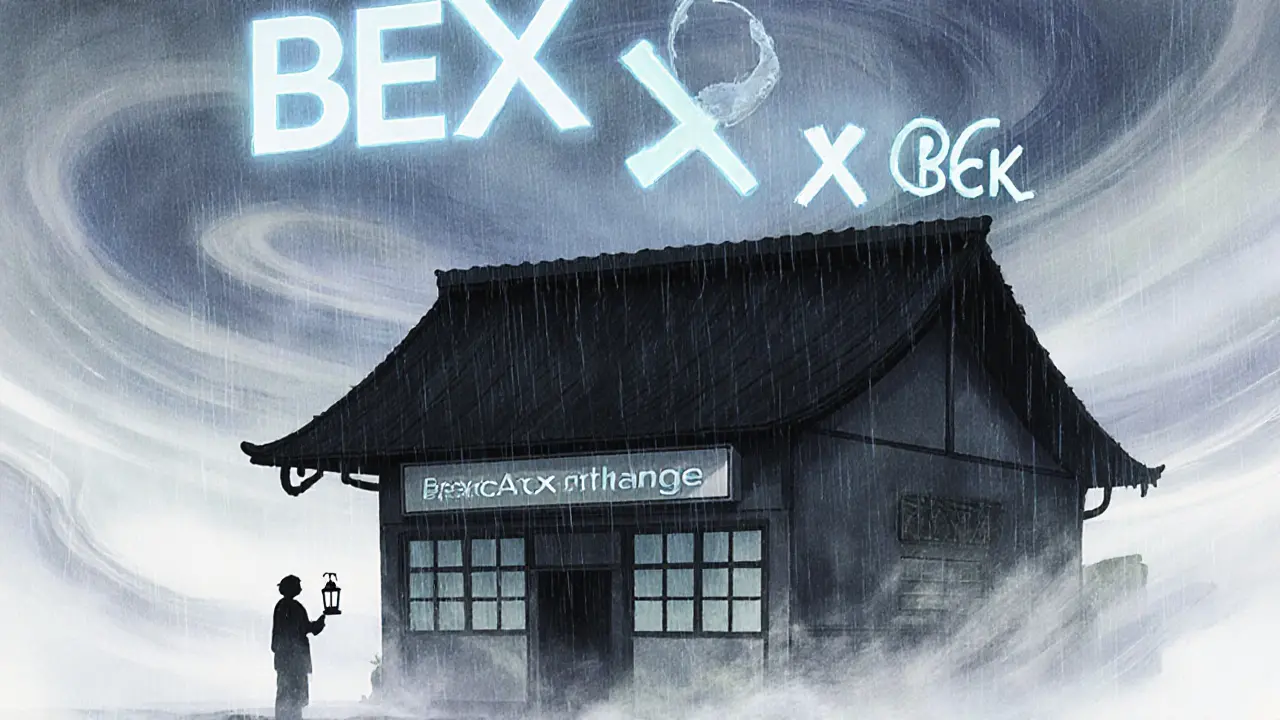Crypto Exchange Safety Checker
Check Exchange Legitimacy
Enter information about the exchange to assess its safety using industry standards. This tool follows the verification checklist from our ParamountDax review.
Risk Assessment
When you hear a new name pop up in the crypto world, the first question is always the same: is it legit or just another rug pull? ParamountDax is one of those names that’s started to circulate in forums and social feeds, but solid information about the platform is scarce. This review walks you through what we could find, how to vet any exchange - especially the low‑profile ones - and how ParamountDax stacks up against the big players you already know.
Quick takeaways
- ParamountDax does not appear in any major exchange listings or regulator databases as of October 2025.
- Without verified licensing, fee schedules, or security audits, the platform carries a high risk profile.
- Established exchanges such as Coinbase, Binance, and Kraken continue to lead in transparency and user protection.
- If you still want to explore ParamountDax, limit exposure to a small test amount and use a hardware wallet for storage.
- Watch community channels like Reddit and review sites such as Trustpilot for emerging feedback.
What we know (and don’t know) about ParamountDax
Our deep‑dive started with a simple Google search, which turned up zero solid results from reputable crypto news outlets, regulator registries, or major comparison guides. The name shows up only in a handful of user‑generated posts, most of which are speculative. No official website, no clear corporate registration, and no public audit reports have surfaced.
Because crypto exchanges operate under strict AML/KYC rules in most jurisdictions, you’d normally see a licence number from bodies like the U.S. FinCEN or Australia’s AUSTRAC. ParamountDax provides none of these credentials, making it impossible to verify its legal standing.
In short, the platform is a mystery box. That doesn’t automatically mean it’s a scam, but the lack of traceable data pushes it into the “high‑risk” category.
How to evaluate any crypto exchange (the checklist)
Before you even think about depositing a single satoshi, run through this checklist. It works for ParamountDax and for every other exchange you might consider.
- Regulatory registration: Look for licence numbers, jurisdiction, and any public statements about compliance.
- Security audits: Reputable exchanges publish third‑party audits (e.g., from CertiK, Quantstamp) and detail their cold‑storage ratios.
- Fee transparency: Clear maker‑taker fees, withdrawal costs, and any hidden charges should be listed on the website.
- Liquidity & volume: High 24‑hour trade volume reduces slippage. You can verify this on sites like CoinMarketCap.
- User reviews: Check Trustpilot, Reddit, and CryptoCompare for real‑world experiences.
- Customer support: Response time, live chat availability, and a detailed help centre are good signs.
- Insurance & protection: Some exchanges (e.g., Gemini) offer custodial insurance for digital assets.
If an exchange fails more than two items on this list, treat it with caution.
Side‑by‑side comparison with the market leaders
| Exchange | Regulatory licence | Security audit (latest) | 24h volume (USD) | Average taker fee | Insurance coverage |
|---|---|---|---|---|---|
| Coinbase | NYDFS, FCA | CertiK 2024 | $1.2 B | 0.50% | $250 M custodial |
| Binance | Malta, Seychelles | Quantstamp 2023 | $3.8 B | 0.10% | None disclosed |
| Kraken | FinCEN, FCA | Trail of Bits 2024 | $900 M | 0.16% | $20 M custodial |
| Gemini | NYDFS, ASIC | CertiK 2024 | $420 M | 0.35% | $200 M custodial |
| ParamountDax | Not disclosed | None available | - | - | - |
Notice the blanks for ParamountDax. Those are red flags. When an exchange can’t provide any of the core data points, the risk spikes dramatically.
Red flags specific to low‑visibility exchanges
- No clear corporate address: A legitimate business will list a registered office and provide a phone line.
- Unverifiable team members: If you can’t find LinkedIn profiles or public biographies, treat the team as anonymous.
- Missing KYC process details: Some platforms hide their verification flow, which can be a tool for laundering.
- Unusually high leverage offers: Scammers lure users with 100x‑plus leverage that’s rarely sustainable on reputable venues.
- Promises of guaranteed returns: Any “fixed‑percentage daily income” claim is a classic Ponzi sign.
Where to find reliable information (beyond the hype)
Even if a new exchange shows up, you can cross‑check it with these sources:
- Regulatory databases: FinCEN’s “Registered Money Services Business” list (U.S.), AUSTRAC’s “Registered Crypto Service Providers” (Australia), and the EU’s “Crypto‑Asset Service Provider” register.
- Blockchain analytics tools: Websites like CoinGecko and CoinMarketCap list verified exchanges and show real‑time trading volumes.
- Third‑party audit firms: Search for PDF audit reports from CertiK, Quantstamp, or PeckShield.
- Community sentiment: Subreddits such as r/CryptoCurrency and r/Bitcoin often surface early user experiences.
- Review platforms: Trustpilot, SiteJabber, and the Google Play/App Store ratings can highlight recurring complaints.
When you apply these sources to ParamountDax, the trail goes cold. No audit, no licence, no volume data.
Final verdict - should you use ParamountDax?
If you’re a seasoned trader who enjoys hunting for hidden gems, you could allocate a tiny testing fund (under $100) to see if the platform actually works. Keep the funds in a non‑custodial wallet, withdraw immediately after the test, and never store large balances on the exchange.
For most users, especially those new to crypto, the safest bet is to stick with established platforms that openly share their security practices, are regulated, and have proven liquidity. The cost of a potential loss on an unknown exchange far outweighs any speculative advantage you might think you’re getting.
Is ParamountDax a legitimate crypto exchange?
There is no verifiable regulatory registration, security audit, or public trading volume for ParamountDax as of October 2025, which makes its legitimacy highly questionable.

How can I verify if a crypto exchange is regulated?
Check the exchange’s licence number on official regulator sites like FinCEN (U.S.), AUSTRAC (Australia), or the EU’s crypto‑asset service provider register. A legitimate exchange will display this information prominently.
What are the biggest risks of using an unknown exchange?
Risks include loss of funds due to hacks, exit scams, lack of insurance, hidden fees, and non‑compliance with AML/KYC laws that could expose you to legal trouble.
Can I test an exchange with a small amount?
Yes, deposit a minimal amount (e.g., $20‑$50) and withdraw immediately after confirming deposits and withdrawals work. Use a hardware wallet for any assets you keep.
Where should I store my crypto for long‑term safety?
A hardware wallet (Ledger, Trezor) or a reputable non‑custodial wallet with strong encryption is best for long‑term holdings. Avoid keeping large balances on any exchange.










Michael Hagerman
October 26, 2025 AT 09:14Alright folks, strap in because the saga of ParamountDax reads like a thriller that never got a director.
First, you hear the whispers and wonder if this is the next big thing or just another smoke‑filled mirror.
The lack of any licence number feels like a missing passport at the border – you just can't get in.
There are zero audit reports, which is the same as walking into a bank with no vault doors.
Every reputable exchange proudly flashes its security certs, but ParamountDax leaves the wall blank.
Even the basic corporate address is nowhere to be found, as if the company lives in a fog.
In the crypto world, anonymity can be a feature, but it can also be a red flag waving in a storm.
Regulators like FinCEN and AUSTRAC keep public registries, and scrolling through those lists yields nothing for this platform.
That vacuum makes any investor’s due diligence feel like searching for a needle in a haystack that doesn’t exist.
One could argue that new projects sometimes hide early details to avoid scrubbing, but that excuse crumbles under the weight of user funds.
Imagine depositing $100 and watching it disappear because the exchange never intended to survive beyond the hype.
Historically, every exchange that vanished left behind a trail of unanswered tickets and vanished wallets.
So far, the community chatter is limited to speculative posts and vague promises of “high leverage” and “guaranteed returns”.
Those promises are the classic bait that lures the unwary into a Ponzi‑style snare.
The safest play? Keep your capital on an exchange that openly shares its security audits, insurance coverage, and regulatory compliance.
If you must test ParamountDax, treat it like a demo – a few dollars, a hardware wallet, and an immediate withdrawal.
Bottom line: the risk of total loss is astronomically higher than any potential upside you might imagine.
Laura Herrelop
October 26, 2025 AT 23:07When you peer behind the veil of a platform that refuses to be cataloged, you’re not just asking “is it legit?” you’re confronting the epistemic abyss of modern finance. It’s as if the market itself is a simulation, and the hidden code is the missing license. Some would say the shadows are where truth hides, but the absence of any regulatory imprint feels less like mystery and more like deliberate obfuscation. If the architects of ParamountDax truly believed in decentralization, why not let the world verify their claims? The silence echoes louder than any advertisement could ever shout.
Nisha Sharmal
October 27, 2025 AT 10:14Oh great, another “mystery exchange” that apparently thinks it can dodge the entire Indian regulatory framework. Sure, let’s trust a platform with zero audit when we have Kraken and Binance to admire. The whole thing screams “I have nothing to hide” – except the fact that there is literally nothing to show. If you’re looking for a high‑risk gamble, you might as well bet on a horse with no saddle.
Karla Alcantara
October 27, 2025 AT 18:34I get why some people are curious about new venues – the crypto space thrives on innovation. That said, it’s totally understandable to feel uneasy when the data points are missing. A little caution doesn’t have to kill the excitement; you can always start with a tiny test amount and see how the platform behaves. Keep your larger holdings safe on exchanges that you trust, and use a hardware wallet for long‑term storage. Ultimately, protecting your assets while staying open to possibilities is the sweet spot.
Jessica Smith
October 28, 2025 AT 01:30ParamountDax is a red flag. No licence no audit no volume. It looks like a scam. Stay away.
Petrina Baldwin
October 28, 2025 AT 07:04Sounds like a warning.
Ralph Nicolay
October 28, 2025 AT 16:47In accordance with standard due‑diligence practices, it is prudent to verify the regulatory status, security audit documentation, and liquidity metrics of any cryptocurrency exchange prior to allocation of capital. The absence of such verifiable information for ParamountDax constitutes a material risk factor warranting circumspection.
sundar M
October 28, 2025 AT 20:57Hey Karla, love the balanced vibe! 🎉 I totally agree – a tiny “pilot” deposit is like sending a scout before the army. If the platform passes the test, you can proceed with confidence, otherwise you’ve saved yourself a lot of grief. Keep the optimism alive but let the facts do the heavy lifting.
Nick Carey
October 29, 2025 AT 03:54Honestly this sounds like another flop waiting to happen.
Sonu Singh
October 29, 2025 AT 12:14Folks, always double check the exchange URL and make sure it uses https. A fake site can look legit but will steal your keys. Also, never share your seed phrase – even if they claim “support”. Keep your crypto in a hardware wallet for real safety.
Peter Schwalm
October 29, 2025 AT 17:47Great advice, Sonu. Using a hardware wallet is the gold standard, and verifying SSL certificates can prevent phishing attacks. If anyone does decide to test a new exchange, keep the amount minimal and withdraw ASAP. Remember, security is a habit, not a one‑time setup.